4. Basic Data Acquisition¶
4.1. Data Modes¶
Hyperspectral data from Resonon imaging systems can be utilized in three forms, as summarized below.
4.1.1. Raw Data¶
This data is spectrally calibrated but contains the instrument sensor response, sample reflectivity and illumination functions. This is the least useful form, as the spectral curves do not have real units or real physical meaning. The units are in Digital Number (DN).
4.1.2. Radiance¶
The raw data can be post-processed to radiance. This requires the imager to be specially calibrated (radiometric calibration) by Resonon at the desired aperture. This data form does not include the instrument sensor response function. This function is corrected for by using the Imager Calibration Pack (ICP file) with the Radiance Conversion plugin in Spectronon (additional information is provided in the Spectronon manual chapter on Advanced Data Analysis 1 Correct / Calibrate data section of the Spectronon manual). The resulting data is the product of illumination and sample reflectivity. It has the advantage of possessing real units (in Microflicks) and physical meaning [microflick = 1 microwatt per steradian per square centimeter of surface per micrometer of span in wavelength].
4.1.3. Reflectivity/Reflectance¶
In reflectance mode, both the instrument sensor response and illumination functions are removed. This leaves the data in absolute reflectance. Data can be converted to reflectance in one of four ways described below. These explanation apply mainly to our airborne and outdoor system users as most benchtop users will be in a lighting controlled environment.
- White reference: Data can be processed to reflectance with a quick calibration against a reflection standard. The highest quality reflection standard is Spectralon, but Teflon is acceptable for many applications. (Note: Teflon needs to be sanded with 100 grit sandpaper on an orbital sander to eliminate any specular properties). This calibration is done with the Record Correction Cube feature, as described below under Calibrate Imager. It is important to note that reflection values are only accurate if the solar illumination (cloud, sun angle, etc) does not change between the collection of the correction cube and the collection of datacubes. Data can also be converted to reflectance using Spectronon’s Reflectance Conversion from Spectrally Flat Reference Cube plugin (see Spectronon manual chapter on Advanced Data Analysis 1 Correct / Calibrate data for more information)
- Known spectral reference in scene: Once the data is in radiance, the spectrum of a reference object in the scene can be used to correct the rest of the cube. The reference spectrum must be known and in a tab or space delimited file, then use the Convert Radiance Cube to Reflectivity from Spectrally Flat Reference Spectrum plugin (see the Spectronon manual chapter on Advanced Data Analysis 1 Correct / Calibrate data for more information).
- Downwelling irradiance sensor: An alternative method for converting data to reflectance is to use a downwelling irradiance sensor. This sensor records the solar spectrum during data acquisition. This data is used, along with the Imager Calibration Pack (ICP files) supplied by Resonon for both the spectral imager and downwelling sensor, in the Reflectivity Conversion from Downwelling Irradiance Data plugin in Spectronon. Again, see the Spectronon manual chapter on Advanced Data Analysis 1 Correct / Calibrate data for more information.
- Atmospheric Correction: Data can be converted to reflectance data with the use of atmospheric correction algorithms such as FLAASH (Fast Line of Sight Atmospheric Analysis of Spectral Hypercubes). Please contact Resonon for more information.
4.2. Start The System¶
If you have a lighting system, turn on the lights and let them warm up. It may require 15 to 20 minutes for the illumination to fully stabilize.
![]()
With the camera and scanning system connected to your computer, launch SpectrononPro software by double-clicking on the SpectrononPro icon or starting SpectrononPro from your Start menu. The SpectrononPro user interface is shown below with the various windows labeled.
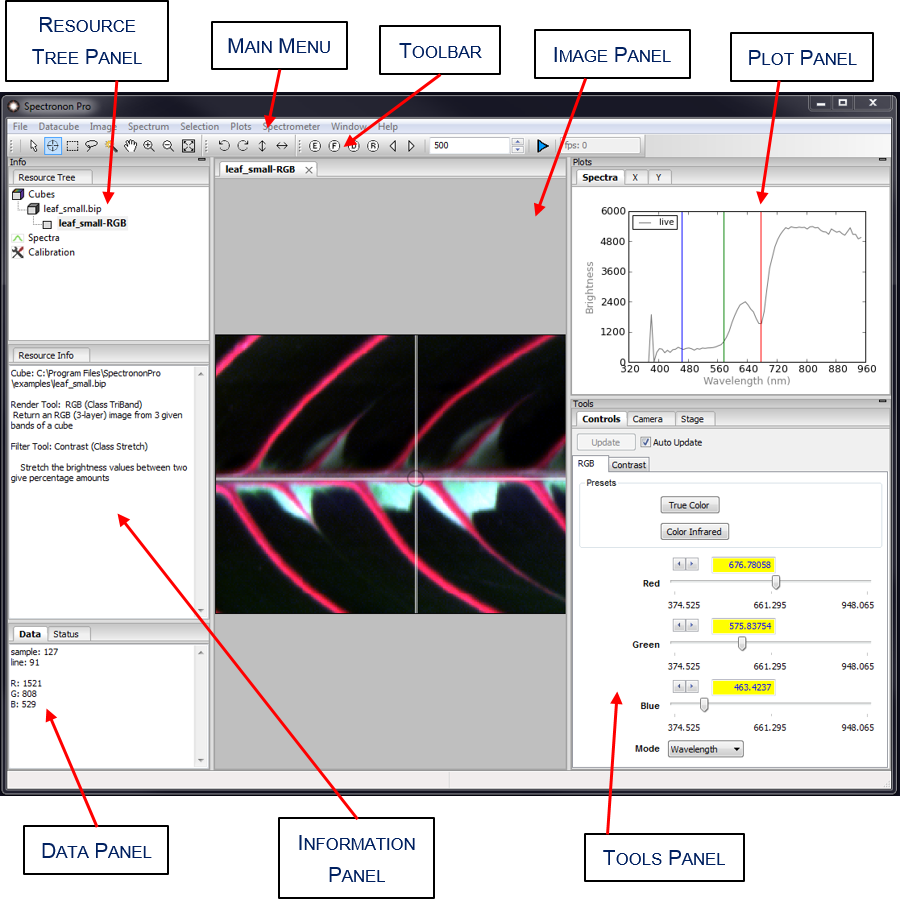
Once the software has started, make sure that the imager and stage controls (if used) are enabled. The imager and stage tools will be greyed out if not enabled, as shown below.

You can get the latest version of SpectrononPro by clicking on Help  Check For Updates. This won’t download the latest version, but will give an alert if there is a newer version.
Check For Updates. This won’t download the latest version, but will give an alert if there is a newer version.
4.3. Camera Controls¶
Exposure parameters can be controlled by clicking on the Camera tab in the Tools Panel.
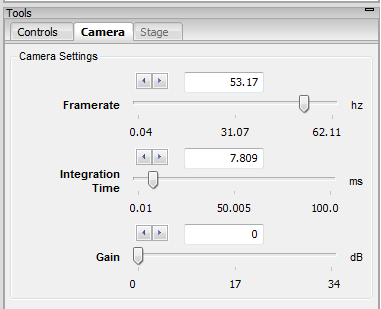
Frame Rate is equal to the number of images acquired each second, and limits the maximum exposure time ( Max Exposure Time = 1.0 ÷ Frame Rate).
Integration Time (also known as Exposure Time) is the duration of data acquisition for each individual line image.
Gain is a factor which increases the signal, but at the expense of signal-to-noise ratio. Try to keep gain as low as possible (preferably zero), unless absolutely necessary. (Note: The Pika NIR camera does not have a gain control tool.)
4.4. Stage Controls¶
You can move the stage manually by clicking on the Jog Stage buttons, located on the tool bar of SpectrononPro. The buttons will move the stage incrementally in either direction. Use the buttons to center the stage underneath the Pika imaging spectrometer.

The stage can be further controlled by clicking on the Stage tab in the Tools Panel.
Speed Units is a setting used for different types of stages. Linear is used for the standard linear translation stage that is installed on most benchtop systems. Rotation is used for a tripod-mounted rotational scanning stage, typically used in outdoor applications. Motor displays speed in “motor pulses per second.”
Stepping Mode controls the way the stage moves in relation to the imager. When the Stepping Mode box is not checked, the stage and imager both run continuously during the scan time.
When the Stepping Mode box is checked, the stage moves incrementally, an image is acquired while the stage is stationary, the stage moves incrementally again, another image is acquired while the stage is stationary, and so on. This behavior is preferable when the scanning speed is very slow, when the integration time is very long, or to guarantee there is no motion blur in your scan.
Scanning Speed is the linear speed of the stage during a scan.
If the “Go Home After” box is checked the stage will return to its starting position after a scan. The speed at which the stage returns to its original position is the Homing Speed, and the Jog Speed is used for the Jog Stage buttons, described above.
4.5. Focus Objective Lens¶
You are now ready to focus the objective lens of your Pika imaging
spectrometer. At first, this process is somewhat challenging, but with a little
practice it becomes quite easy. Begin by clicking on the Focus button
 located on the SpectrononPro tool bar. This will reveal a live
image from the camera within your Pika imaging spectrometer. (Wave your hand in
the field of view of your Pika imaging spectrometer to confirm that the image
is a live view.) One axis of this image represents the spatial (position) axis
of your object, and the other is the spectral (wavelength) axis. (To understand
this view better, move colored objects within the field of view of your imager
after you have focused the objective lens.)
located on the SpectrononPro tool bar. This will reveal a live
image from the camera within your Pika imaging spectrometer. (Wave your hand in
the field of view of your Pika imaging spectrometer to confirm that the image
is a live view.) One axis of this image represents the spatial (position) axis
of your object, and the other is the spectral (wavelength) axis. (To understand
this view better, move colored objects within the field of view of your imager
after you have focused the objective lens.)
Place an object with multiple light and dark regions within your Pika imaging spectrometer’s field of view. A sheet of paper with dark lines, as provided in the chapter titled Focusing & Calibration Sheets, works well. If you are in the field and are observing objects at a distance, direct your Pika towards an object with multiple features, such as a tree with many branches. Unless your lens is already focused, you will see a series of blurry or barely discernible lines in the Image Panel of SpectrononPro.
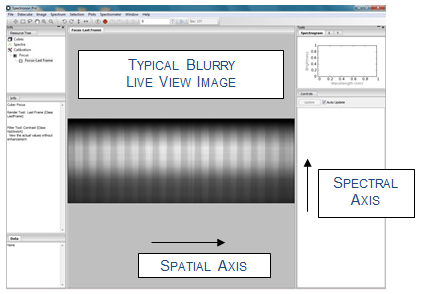
To adjust the focus, first unlock the focus adjustment. With Schneider lenses, this is done by loosening the locking metal collar on your objective lens using an Allen wrench, size 5/64 inch.

Then rotate the objective lens until you see dark lines from your object come into focus, as shown. Maximize the sharpness of the lines.
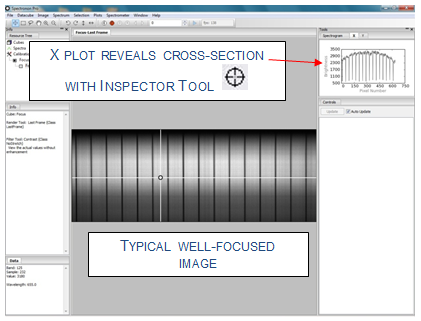
Hint
Clicking the Inspector Tool  in the Image Panel, and then
selecting X tab in the Plots window will reveal a cross-section plot of your
image. Viewing this plot allows you to graphically see the sharpness of your
focusing. You can zoom in on the X-axis by clicking the Zoom tool
in the Image Panel, and then
selecting X tab in the Plots window will reveal a cross-section plot of your
image. Viewing this plot allows you to graphically see the sharpness of your
focusing. You can zoom in on the X-axis by clicking the Zoom tool  and then clicking on the X-axis.
and then clicking on the X-axis.
Focusing the outdoor system can be a little more challenging than the benchtop system. If you are focusing on objects that are further than 40 feet start the process with the objective lens screwed in close to the collar. A method that has proven useful is to start the focusing process by increasing the number of lines scanned to 1000. This will give you a large scan area to begin the process. You will need to be out of live focus mode when performing this focusing procedure (“F” button should not be red). When the scan begins make a quarter turn with the lens. Continue to make quarter turns until you are confident your scene is in focus. When making the quarter turn intentionally place your hand in front of the lens. This will create a thin black line in the scan separating one focus length from its neighbor, allowing for easier comparison. This process can take some time, so be patient and remember that it will get easier with practice.
Once you have completed focusing, re-tighten the lock to the focus adjustment.
Then click on the Focus  tool again to toggle the camera live view
off.
tool again to toggle the camera live view
off.
Hint
See our You Tube video on focusing the benchtop system at http://www.youtube.com/resonon.
4.6. Imager Calibration¶
The following discussion describes how to set up your system to scan for reflectance scaled to a reference object. If you wish to collect raw data and convert it to radiance do not perform the following correction process.
4.6.1. Remove Dark Current¶
SpectrononPro makes it easy to remove the average dark current noise from your
scans. Begin by clicking on the Dark Current button  on
the SpectrononPro toolbar. You will be instructed to block all light entering
your Pika imaging spectrometer by blocking the objective lens.
on
the SpectrononPro toolbar. You will be instructed to block all light entering
your Pika imaging spectrometer by blocking the objective lens.
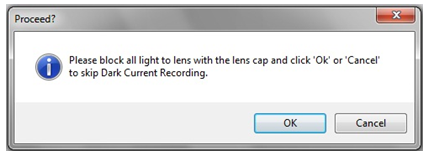
Once you have the objective lens blocked, click OK as instructed. SpectrononPro will then
collect multiple dark frames and use these measurements to subtract the dark
current noise from your measurements. The Dark Current button on the
toolbar will appear with a red check through it as soon as the dark frames have
been collected  . Once you see the red check, unblock the
objective lens.
. Once you see the red check, unblock the
objective lens.
4.6.2. Set Reflectance Reference¶
Measuring absolute reflectance of an object requires correction to account for illumination effects.
To do this, click on the Response Correction Cube button  on the
SpectrononPro toolbar. A message will appear telling you to place a reference
material within your Pika imaging spectrometer’s field of view. The reference
material should be uniform across the imager’s field of view. Examples of
reference materials include Spectralon® or sheets of white Teflon.
on the
SpectrononPro toolbar. A message will appear telling you to place a reference
material within your Pika imaging spectrometer’s field of view. The reference
material should be uniform across the imager’s field of view. Examples of
reference materials include Spectralon® or sheets of white Teflon.
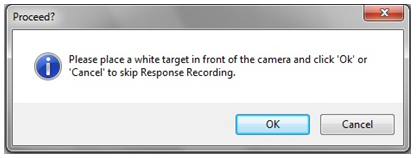
Once the reference material is in place, click on OK. This will trigger a short scan
of the reference material. Once complete, the Response Correction Cube will
appear with a red check mark  , indicating that the data
you collect will be scaled in reflectance to your reference material, including
flat-fielding to compensate for spatial variations in your lighting.
, indicating that the data
you collect will be scaled in reflectance to your reference material, including
flat-fielding to compensate for spatial variations in your lighting.
Note
The Dark Current button  and the Response Correction Cube
button
and the Response Correction Cube
button  are disabled in live camera view mode. Click on the
Focus
are disabled in live camera view mode. Click on the
Focus  tool to toggle the camera live view off.
tool to toggle the camera live view off.
Once the imager is calibrated for both dark current and reflectance reference,
the imager will remain calibrated until the references are removed by the user, or
the machine is turned off. If the integration time is changed by the user after calibration,
the reference signals will be adjusted accordingly. To manually remove the references, click Spectrometer
 Remove Dark Current Cube, and Spectrometer
Remove Dark Current Cube, and Spectrometer  Remove Response Correction Cube.
Remove Response Correction Cube.
For additional help with this process see our Calibration video at http://www.youtube.com/resonon.
4.6.3. Adjust Aspect Ratio¶
Scanning objects continuously (i.e., with Stepping Mode off) is faster and usually the preferred method. However, when scanning continuously the initial image will usually be distorted along the scan dimension. To correct this distortion, you must calibrate the Scanning Speed of the stage relative to the or Framerate, which is the line acquisition rate of the camera.
Recall that Pika imaging spectrometers are line-scan instruments. By adjusting the stage speed of the scanning system relative to the frame rate, you are adjusting the spacing of the lines used to assemble your image. Thus, some adjustments are necessary to scan images with a unity aspect ratio that gives the proper proportion between the scan direction and the line direction.
To adjust your scan’s aspect ratio, it is useful to first image an object whose
distortion is easy to observe, such as a circle. Print out the Pixel Aspect Ratio
Calibration Sheet provided in the Focusing & Calibration Sheets chapter
of this manual for this purpose. After placing an object with circles within the
field of view of your Pika imaging spectrometer, record a scan with enough lines
that you can see the complete circle. (200 lines are usually sufficient.) Record
the scan by clicking on the Scan Button  , and a waterfall image
should appear in the Image Panel of SpectrononPro. You may need to record several
trial images to determine how many lines to scan and where to best position the object.
, and a waterfall image
should appear in the Image Panel of SpectrononPro. You may need to record several
trial images to determine how many lines to scan and where to best position the object.

Note
You can stop a scan by re-clicking on the Scan Button  ,
which changes to the Stop Button
,
which changes to the Stop Button  during the scan.
during the scan.
If your image is distorted along the scan direction, you will need to change the Scanning Speed on the Stage tab on the Tools panel. If your image is elongated along the scan direction, then the stage was moving too slowly in relation to the frame rate (over-sampling), and you need to increase the scanning speed. Conversely, if your image is compacted along the scan direction, then the stage was moving too quickly in relation to the frame rate (under-sampling), and you should decrease the scanning speed.
Note
Alternatively, the Framerate can be adjusted in relation to a fixed Scanning Speed. However, a faster Framerate corresponds to a lower maximum Integration Time and thus limits the available signal.
Repeat the above process until your image is no longer distorted. For additional help setting the aspect ratio see our Setting Aspect Ratio video at http://www.youtube.com/resonon.
A distortion-free image with unit aspect ratio is achieved when the stage/object advances the distance of the projected image of one spatial pixel per each line acquired at the imager’s given frame rate. Thus, changing the Framerate setting requires updating the stage speed to maintain unity aspect ratio, while changing only the Integration Time does not. Similarly, changing the working distance of the imager to the stage changes the object magnification, and thus changes the aspect ratio for any particular Framerate and Scanning Speed combination.
4.7. Scanning and Saving Datacubes¶
To scan an image of an object after calibrating the system, place the object
on the stage within the imager’s field of view and type in the number of lines
you would like to scan in the window just to the left of the Scan Button
 . Record a hyperspectral datacube (the image) by pressing the Scan
Button
. Record a hyperspectral datacube (the image) by pressing the Scan
Button  . (Click
. (Click  to terminate the scan early, if needed.)
Adjust the stage position and increase/decrease the number of lines as needed to
cover the object’s feature(s) of interest.
to terminate the scan early, if needed.)
Adjust the stage position and increase/decrease the number of lines as needed to
cover the object’s feature(s) of interest.
A waterfall image of your datacube will appear in the Image Panel of Spectronon,
and a new entry labeled Current Scan will appear in the Resource Tree.
To save the scanned datacube, use your mouse to select Current Scan
and then either right-click or select Datacube  Save Cube. This will open a dialog window that allows you to name the datacube
and save it in a folder of your choosing. If you do not save your datacube, the
Current Scan will be overwritten when you record another datacube, and
a warning should appear.
Save Cube. This will open a dialog window that allows you to name the datacube
and save it in a folder of your choosing. If you do not save your datacube, the
Current Scan will be overwritten when you record another datacube, and
a warning should appear.
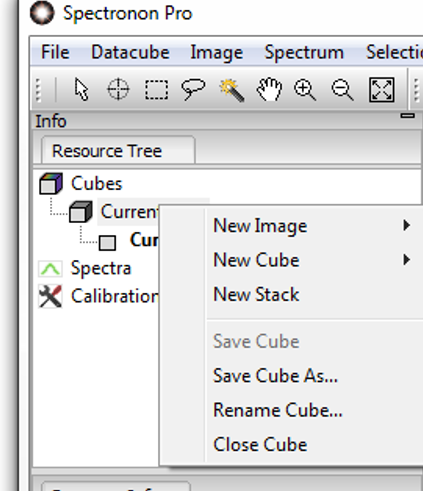
For additional help scanning and saving datacubes see our Scanning and Saving video at http://www.youtube.com/resonon. Once an image is scanned, you can use all the visualization and analysis tools of Spectronon on your image.
